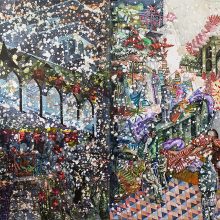Heading Utopia
Behrang Samadzadegan
“…did not assume paradise to be a place that could be discovered. There were no maps that could be discovered. There were no maps that could lead a man to it, no instruments of navigation that could guide a man to its shores. Rather, its existence was immanent within man himself: the idea of a beyond he might someday create in the here and now. For utopia was nowhere—even […] in its ‘wordhood.’ And if man could bring forth this dreamed-of place, it would only be by building it with his own two hands.” —Paul Auster, City of Glass
Images claim to be versions of the truth. Yet, “truth is singular and its versions are mistruth.” How would images represent the lived history that includes wisdom and ignorance? Also, how would a virtual image become mans’ ideal to attain Utopia? In the way to achieve this virtuality, how do we respond to an existence that is loaded with memories? How do we handle the distance between the present and the past? And how do we tackle the losses that are inevitable results of that distance?


